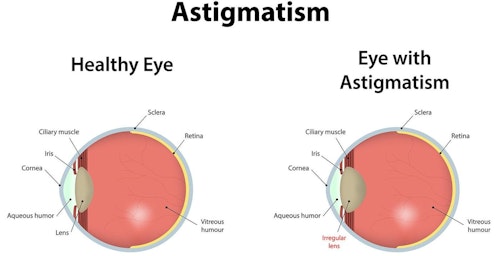According to sources, astigmatism affects between 30 and 60 percent of the adult population in certain areas. That means you may want to get your hands on a display model at a store before you shell out the money for a sight that may not offer the crisp 1 MOA reticle you’re looking for. Here’s what you need to know about using a red dot or reflex sight if you have, or think you might have, an astigmatism.
First, you should understand what an astigmatism is. The American Optometric Association describes an astigmatism as occurring when the cornea (the clear front cover of the eye) is irregularly shaped or sometimes because of the curvature of the lens inside the eye. What that means is, as light enters the eye, rather than being focused properly on the retina at the back of the eye, the irregular shaped cornea scatters the light on the retina causing a blurred image. This blurring of the image is made worse when the focal point is a direct source of light, such as a red dot sight.
Now that you know the medical jargon, you can begin to understand and diagnose what you might see when you look through a red dot sight. As one of the many adults with an astigmatism, I notice it most when I’m driving at night. The headlights appear to have spears of light shooting up and down from the main light source. So rather than two spherical headlights, I see something that more closely resembles two vertical lines of light. Like a headlight, the reticle of a red dot sight is produced by a single source of light reflected back to the user off a mirror. Individuals with an astigmatism may see a reticle that appears blurry, distorted or even doubled in some cases.

Before you go blaming the sight thinking it’s defective, try this trick. To diagnose whether a distorted reticle is caused by an astigmatism or a faulty sight, take a picture of the reticle. If the sight is to blame, the image of the reticle will appear distorted. If the user’s vision is to blame, the image of the reticle will appear clear.
If you’ve determined the sight isn’t to blame, but you still have your heart set on a red dot style sight, here are some things to try. Limiting the amount of light entering the eye while looking at the reticle can help reduce the effects of the astigmatism. This can be achieved by mounting a peep sight to the rail between the red dot and your eye. The settings of the sight itself may also be of some assistance. Using a lower brightness setting can also alleviate some of the distortion.
If those suggestions don’t help, a different type of sight may be in order. Before moving away from a lighted reticle sight altogether, try a holographic or prismatic sight first. Both types of sights use a slightly different method of light transmission to create the reticle, and many users with an astigmatism have said these types of sights produce less distortion. But if those don’t work, it may be time to consider an optic with low or no magnification.
It’s possible you didn’t even know you had an astigmatism before you started shopping for a red dot sight. Though a blurry or distorted reticle is a good indication of an astigmatism, you should be diagnosed by an optometrist. A trip to the eye doctor could set you up with the tools you need to fully appreciate a red dot sight. Glasses, contacts and corrective surgery can all reduce, or in some cases eliminate, the symptoms of an astigmatism.






